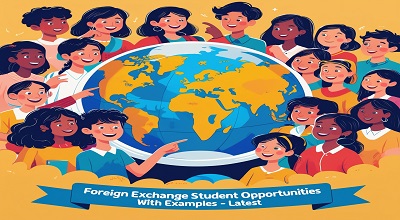Foreign Exchange Student Opportunities
Foreign Exchange Student Opportunities: Foreign exchange programs offer students the opportunity to study abroad, immerse themselves in new cultures, and gain global perspectives. These programs are designed for high school, university, and even postgraduate students who wish to experience education in a different country.
Exchange programs vary in duration—some last a few weeks, while others extend for a full academic year. Governments, educational institutions, and private organizations sponsor these programs to promote international understanding and academic collaboration.
Benefits of Being a Foreign Exchange Student
Academic Growth
- Exposure to different teaching methodologies
- Access to specialized courses not available in home country
Cultural Enrichment
- Learning new languages and traditions
- Building lifelong international friendships
Career Advantages
- Enhanced resume with global experience
- Networking opportunities with professionals worldwide
Personal Development
- Increased independence and adaptability
- Improved problem-solving and communication skills
Top Foreign Exchange Programs Worldwide
Here are some of the most reputable foreign exchange programs available today:
A. High School Exchange Programs
- AYUSA (Academic Year in the USA) – U.S.-based program for high school students.
- Rotary Youth Exchange – Global network offering exchanges in over 100 countries.
- EF (Education First) High School Exchange Year – Programs in the U.S., UK, and Europe.
B. University Exchange Programs
- Erasmus+ (Europe) – Funded by the EU for students in member countries.
- Fulbright Program (USA) – Prestigious scholarships for international students.
- ISEP (International Student Exchange Programs) – Network of 300+ universities worldwide.
C. Short-Term and Summer Exchange Programs
- CIEE (Council on International Educational Exchange) – Summer and semester programs.
- Youth For Understanding (YFU) – Cultural immersion programs for teens.
- AFS Intercultural Programs – Offers study abroad experiences in 50+ countries.
How to Apply for Foreign Exchange Programs?
Step-by-Step Application Process
- Research Programs – Identify the best fit based on destination, duration, and cost.
- Check Eligibility – Review age, academic, and language requirements.
- Prepare Documents – Passport, transcripts, recommendation letters, and essays.
- Apply Early – Deadlines vary; some programs require applications 6-12 months in advance.
- Interview Process – Many programs conduct interviews to assess suitability.
- Visa & Travel Arrangements – Secure a student visa and book flights.
Challenges Faced by Exchange Students
Common Difficulties
- Language Barriers – Struggling with fluency in a new language.
- Homesickness – Missing family and friends back home.
- Cultural Shock – Adjusting to different social norms and lifestyles.
- Academic Differences – Adapting to new grading systems and teaching styles.
How to Overcome Challenges?
- Join student support groups
- Stay in touch with family via video calls
- Engage in local cultural activities
Success Stories of Foreign Exchange Students
Example 1: Maria from Spain
- Participated in Erasmus+ in Germany
- Gained fluency in German and secured a job at a multinational company.
Example 2: John from the USA
- Joined Rotary Youth Exchange in Japan
- Developed a passion for robotics and later studied engineering at Tokyo University.
Latest Trends in Foreign Exchange Programs
- Virtual Exchange Programs – Online cultural exchanges due to travel restrictions.
- Sustainability-Focused Exchanges – Programs emphasizing eco-friendly practices.
- Increased Diversity – More opportunities for students from developing countries.
Financial Aid and Scholarships for Exchange Students
Popular Scholarships
- Fulbright Scholarships (USA)
- Chevening Scholarships (UK)
- DAAD Scholarships (Germany)
Tips for Securing Funding
- Apply for multiple scholarships
- Look for country-specific grants
- Check university partnerships
Cultural Adaptation Tips for Exchange Students
- Learn basic phrases in the local language
- Be open-minded and respectful of traditions
- Participate in local festivals and events
Future of Foreign Exchange Programs
- More hybrid (online + in-person) exchanges
- Greater emphasis on global citizenship education
- Expansion of programs in emerging economies
Frequently Asked Questions (FAQs)
Q1: What is the best age to become a foreign exchange student?
Most programs cater to high school (15-18) and university students (18+).
Q2: How much does a foreign exchange program cost?
Costs vary—some are fully funded, while others range from 5,000to5,000to20,000.
Q3: Can I work while on an exchange program?
Some countries allow part-time work for students; check visa regulations.
Q4: How do I choose the right exchange program?
Consider factors like destination, duration, cost, and academic offerings.
Q5: What if I face discrimination abroad?
Report issues to program coordinators and seek support from local student groups.
Conclusion
Foreign exchange programs provide life-changing experiences, fostering academic, personal, and professional growth. With the right preparation, students can make the most of these opportunities and build a global network.
Free Here: Drag Racing MOD APK
